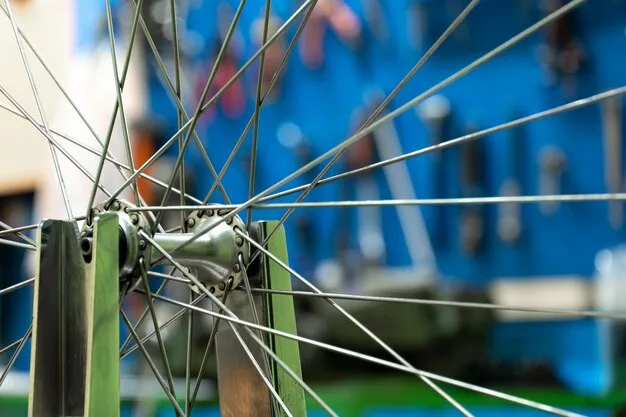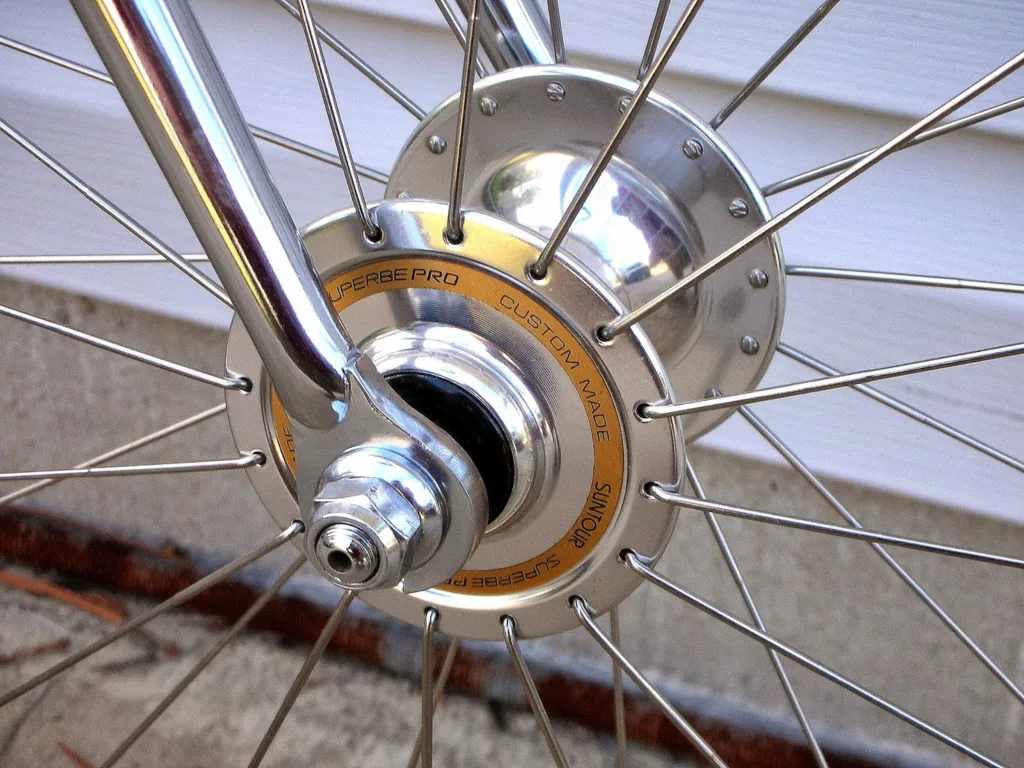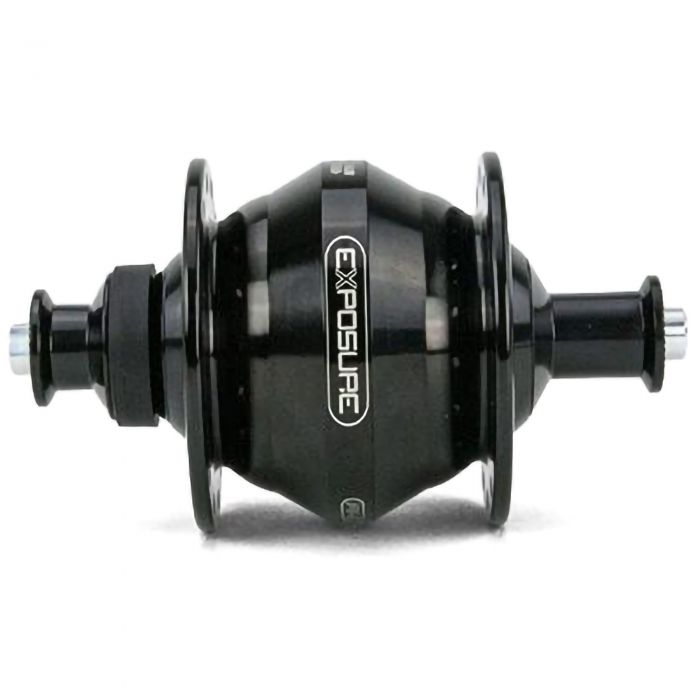In the intricate process of bike wheel building, the hub flange plays a crucial yet often overlooked role. This article aims to shed light on the importance of the hub flange, explaining its function in the wheel’s structure and how it impacts overall cycling performance. We’ll delve into aspects like wheel stability, strength, and the effect of hub flange size and positioning on these factors. Whether you’re a bike mechanic, an enthusiast assembling your own wheels, or simply a cyclist curious about the mechanics of your ride, understanding the significance of the hub flange will give you deeper insights into what makes a well-built and efficient bicycle wheel.
Table of Contents
Toggle1. What is the role of the hub flange in a bike wheel?
The hub flange plays a crucial role in the construction of a bike wheel. It is the part of the hub where the spokes are attached, and it is responsible for distributing the load evenly across the wheel. The flanges are typically positioned on either side of the hub and are designed to provide the necessary support for the spokes, which in turn support the rim and tyre.
The size and position of the flange can significantly impact the performance and durability of the wheel. A larger flange diameter can provide a stronger wheel due to the increased bracing angle of the spokes. This can be particularly beneficial for mountain bikes or other types of bikes that are subject to high levels of stress.
However, the larger the flange, the heavier the wheel, which can impact the bike’s speed and agility. Therefore, it’s essential to find a balance between strength and weight when choosing a hub with the right flange size for your bike wheel.
The material of the flange is also an important consideration. Most flanges are made from aluminium due to its strength and lightweight properties, but steel flanges are also available for those looking for extra durability.
The flange’s design can also vary, with some featuring holes for the spokes, while others use slots. The choice between these two designs largely depends on personal preference and the type of spokes being used.
In summary, the hub flange is a critical component of a bike wheel, and understanding its role can help you make informed decisions when building or repairing your bike wheel.
2. How does the hub flange affect the performance of a bike wheel?
The hub flange can significantly impact the performance of a bike wheel in several ways. Firstly, the flange’s size and position can influence the wheel’s strength and stability. A larger flange diameter can provide a stronger wheel due to the increased bracing angle of the spokes. This can be particularly beneficial for mountain bikes or other types of bikes that are subject to high levels of stress.
However, the larger the flange, the heavier the wheel, which can impact the bike’s speed and agility. Therefore, it’s essential to find a balance between strength and weight when choosing a hub with the right flange size for your bike wheel.
The material of the flange is also an important consideration. Most flanges are made from aluminium due to its strength and lightweight properties, but steel flanges are also available for those looking for extra durability.
The flange’s design can also vary, with some featuring holes for the spokes, while others use slots. The choice between these two designs largely depends on personal preference and the type of spokes being used.
In summary, the hub flange can significantly impact the performance of a bike wheel, and understanding its role can help you make informed decisions when building or repairing your bike wheel.

3. What are the different types of hub flanges?
There are several types of hub flanges available, each with their own advantages and disadvantages. The most common types include:
- Standard Flanges: These are the most common type of flange and are typically made from aluminium. They feature holes for the spokes and are designed to provide a good balance between strength and weight.
- High Flanges: These flanges have a larger diameter than standard flanges, providing a stronger wheel due to the increased bracing angle of the spokes. However, they are also heavier, which can impact the bike’s speed and agility.
- Low Flanges: These flanges have a smaller diameter than standard flanges, resulting in a lighter wheel. However, they also provide less support for the spokes, which can reduce the wheel’s strength and durability.
- Aero Flanges: These flanges are designed to reduce air resistance and improve aerodynamics. They are typically used on road and racing bikes.
- Disc Brake Flanges: These flanges are designed to accommodate disc brakes. They are typically larger and stronger than standard flanges to handle the increased stress from the braking system.
Each type of flange has its own advantages and disadvantages, and the best choice depends on the type of bike and the rider’s individual needs and preferences.
4. How to choose the right hub flange for your bike wheel?
Choosing the right hub flange for your bike wheel depends on several factors, including the type of bike, the intended use of the bike, and the rider’s individual needs and preferences.
For road and racing bikes, a low flange or aero flange may be the best choice. These flanges are lighter and designed to reduce air resistance, which can improve speed and agility.
For mountain bikes or other types of bikes that are subject to high levels of stress, a high flange or disc brake flange may be the best choice. These flanges are stronger and provide better support for the spokes, which can improve durability and stability.
The material of the flange is also an important consideration. Most flanges are made from aluminium due to its strength and lightweight properties, but steel flanges are also available for those looking for extra durability.
Finally, the design of the flange should also be considered. Some flanges feature holes for the spokes, while others use slots. The choice between these two designs largely depends on personal preference and the type of spokes being used.
In summary, choosing the right hub flange for your bike wheel requires careful consideration of several factors, and it’s always a good idea to seek expert advice if you’re unsure.
5. How to install a hub flange on a bike wheel?
Installing a hub flange on a bike wheel can be a complex process and requires a certain level of technical skill. Here is a basic step-by-step guide:
- Remove the Old Hub: The first step is to remove the old hub from the wheel. This typically involves removing the wheel from the bike, deflating the tyre, and removing the rim tape to expose the spokes. The spokes can then be removed from the hub using a spoke wrench.
- Prepare the New Hub: The new hub should be prepared by applying a thin layer of grease to the flange holes or slots. This will help to protect the hub from corrosion and make it easier to insert the spokes.
- Insert the Spokes: The spokes should be inserted into the flange holes or slots in a specific pattern, depending on the type of wheel. This is a critical step, as the correct spoke pattern is essential for the strength and stability of the wheel.
- Attach the Rim: Once the spokes have been inserted, the rim can be attached. This involves threading the spokes through the rim holes and tightening them using a spoke wrench. The tension of the spokes should be checked and adjusted as necessary to ensure the wheel is straight and balanced.
- Reinstall the Wheel: Finally, the wheel can be reinstalled on the bike. The tyre should be inflated to the correct pressure, and the wheel should be checked for any signs of wobbling or misalignment.
This is a basic guide and may not cover all aspects of hub flange installation. It’s always recommended to seek professional help if you’re unsure.

6. What are the common problems associated with hub flanges?
While hub flanges are designed to be durable and reliable, they can still encounter problems. Some of the most common issues include:
- Cracks: Over time, the stress from the spokes can cause cracks to form in the flange. This can compromise the strength and stability of the wheel and may require a replacement flange.
- Corrosion: If the flange is not properly maintained, it can corrode. This can weaken the flange and lead to failure. Regular cleaning and lubrication can help to prevent this.
- Misalignment: If the flange is not correctly aligned with the hub, it can cause the wheel to wobble or vibrate. This can affect the bike’s performance and may require adjustment or replacement of the flange.
- Spoke Tension Issues: If the spokes are not correctly tensioned, it can put undue stress on the flange and lead to problems. Regular checks and adjustments can help to prevent this.
If you encounter any of these problems with your hub flange, it’s important to address them as soon as possible to prevent further damage.
7. How to maintain and care for your hub flange?
Proper maintenance and care can significantly extend the life of your hub flange and improve the performance of your bike wheel. Here are some tips:
- Regular Cleaning: Dirt and grime can build up on the flange and cause it to corrode. Regular cleaning with a mild detergent and a soft brush can help to prevent this.
- Lubrication: Applying a thin layer of grease to the flange holes or slots can protect against corrosion and make it easier to insert and remove the spokes.
- Check for Cracks: Regularly inspect the flange for any signs of cracks or damage. If any are found, the flange should be replaced as soon as possible.
- Spoke Tension: Check the tension of the spokes regularly and adjust as necessary. Incorrect spoke tension can put undue stress on the flange and lead to problems.
- Professional Service: Consider having your wheel serviced by a professional every year or two. They can check the flange and other components for any signs of wear or damage and perform any necessary repairs or replacements.
By following these tips, you can keep your hub flange in good condition and ensure your bike wheel performs at its best.

8. What are the best brands for hub flanges?
There are many brands that manufacture hub flanges, each with their own strengths and weaknesses. Some of the most reputable brands include:
- Shimano: Known for their high-quality bike components, Shimano offers a range of hub flanges suitable for various types of bikes.
- Campagnolo: This Italian brand is renowned for its high-performance bike components, including hub flanges.
- DT Swiss: Specialising in bike wheels, DT Swiss offers a range of high-quality hub flanges designed for strength and durability.
- Mavic: Known for their innovative designs, Mavic offers a range of hub flanges that are lightweight and aerodynamic.
- Chris King: This American brand is known for its high-quality, durable bike components, including hub flanges.
When choosing a brand, it’s important to consider the type of bike, the intended use of the bike, and the rider’s individual needs and preferences. It’s also a good idea to read reviews and seek expert advice to ensure you choose the best brand for your needs.
9. How much does a hub flange cost?
The cost of a hub flange can vary widely depending on the brand, the material, and the design. On average, you can expect to pay between £20 and £100 for a hub flange.
Standard flanges are typically the cheapest option, while high flanges, aero flanges, and disc brake flanges tend to be more expensive due to their specialised designs.
It’s important to remember that while price is an important consideration, it should not be the only factor. The quality, durability, and suitability of the flange for your specific needs are just as important, if not more so.
It’s also worth considering the cost of installation, especially if you’re not confident in doing it yourself. Some bike shops offer free installation with the purchase of a flange, while others charge a small fee.
In conclusion, while a hub flange is a relatively small component of a bike wheel, it plays a crucial role in the wheel’s performance and durability. By understanding the importance of the hub flange and how to choose, install, and maintain the right one for your needs, you can ensure your bike wheel performs at its best.







